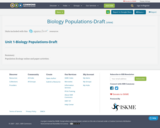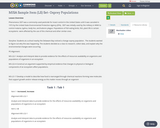
Population Ecology online and paper activities.
- Subject:
- Biology
- Life Science
- Material Type:
- Activity/Lab
- Date Added:
- 07/24/2019

Population Ecology online and paper activities.

Phenomena: DDT was a commonly-used pesticide for insect control in the United States until it was cancelled in 1972 by the United State Environmental Protection Agency (EPA). DDT was initially used by the military in WWII to control malaria, typhus, body lice, and bubonic plague. Populations of fish eating birds, fish, plant life in certain ecosystems were affected by the use of this chemical and other similar ones.Storyline: Students at a school nearby the Delaware Bay noticed a change in osprey population. The students wanted to figure out why this was happening. The students decided as a class to research, collect data, and explain why the environmental changes were occurring.PE Alignment: MS-LS2-1 Analyze and interpret data to provide evidence for the effects of resources availability on organisms and populations of organisms in an ecosystemMS-LS2-4 Construct an argument supported by empirical evidence that changes to physical or biological components of an ecosystem affect populations. MS-LS1-7 Develop a model to describe how food is rearranged through chemical reactions forming new molecules that support growth and/or release energy as this matter moves through an organism

This video segment adapted from the NOW-RAMP 2002 Expedition documents a research expedition to Nihoa Island. It showcases Nihoa's unique birds and plants, the threat posed by invading grasshoppers, and restoration efforts.

In this video adapted from Texas Parks and Wildlife Department, see how volunteers care for sick or injured animals. Also learn why human interaction is not always the best solution.